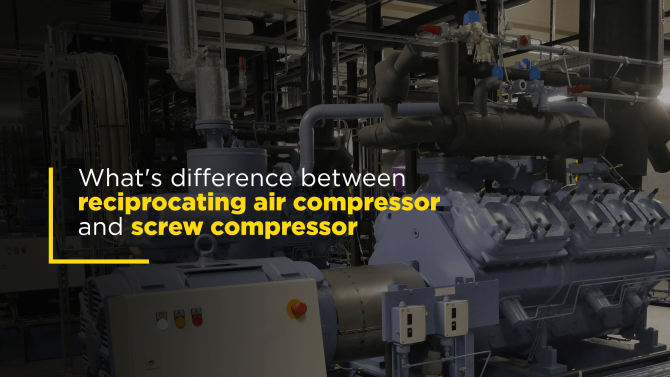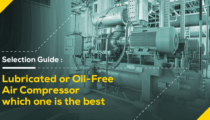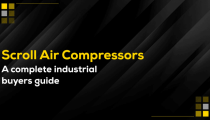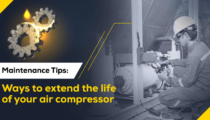When the time comes to determine the type of air…

What’s The Difference Between Reciprocating Air Compressor and Screw Compressor?
Among the various types of air compressors currently available, reciprocating compressors (also known as piston-type air compressors) and screw air compressors are by far the most popular. For buyers, it is extremely important to know the differences between these two types – in order to make an informed decision on the type of air compressor to go for. In what follows, the main differences between reciprocating air compressors and rotary screw compressors have been highlighted:
Way of Operation
Piston-type compressors and rotary screw compressors differ in the way in which they generate compressed air. While the former have crankshafts that power the pistons which perform the air compression, the latter have ‘air-ends’ or ‘rotors’ (two meshed helical screws) for doing the same task.
Typically, a reciprocating air compressor has more mobile parts (piston & piston rings, valves, crankshafts, rods, etc.) than the screw compressor models. In fact, screw air compressors have only a couple of moving parts – and they do not touch each other either.
Screw air compressors are significantly more compact than reciprocating compressors. As such, they can be set up easily in relatively small spaces. A piston air compressor, however, requires a much larger space to function properly.
Expenses & Usability
When you buy a compressed air system, the upfront cost is not the only factor you need to consider. The energy expenses also need to be factored in – to get an idea of the total effective cost . While a reciprocating air compressor can require upto 40% less initial investment than a screw air compressor – the latter is considerably more energy-efficient (particularly for high CFM (Cubic Feet per Minute)).
Another important difference between the two types of air compressors is the noise they generate during operations. With piston-type compressors, the noise can go up to 100 dB – while the noise from rotary screw air compressors generally does not exceed 75 dB. Hence, screw air compressors are the ‘quieter’ option.
For appliances that need continuous air, screw compressors – with their 100% duty cycle – is the better choice. On the other hand, for applications that are powered by short and intermittent air bursts, buyers should go with reciprocating compressors.
Impact Of Moving Parts In The Air Compressor
Since screw air compressors have just the two moving parts – there is practically no chance of any friction being generated internally. That however, is not the case with piston-type air compressors. In these, the piston rings regularly come in contact with the cylinder walls, generating friction.
The presence of friction in reciprocating compressors pulls up their internal operating temperature to well over 150°C. Screw compressors have zero friction – and as a result, their internal temperature does not go beyond the 85°-99° range.
The higher number of moving parts in reciprocating air compressors makes them more exposed to mechanical wear-and-tear. That, in turn, affects reliability and increases probable downtimes. On the other hand, screw air compressors have minimal mechanical fatigue and higher reliability.
Maintenance & Longevity
Reciprocating air compressors require very little maintenance. They can be used in even fairly unclean indoor/outdoor environments. In contrast, rotary screw compressors are highly sensitive to their surroundings – and they need to be maintained by skilled professionals. They should ideally be set up in clean areas.
When taken care of properly, screw air compressors deliver much better durability and longevity than their reciprocating counterparts. The higher CFM per horsepower (HP) is yet another advantage of the rotary compressors.
Generally, reciprocating compressors require grouting and a separate foundation. These are needed to manage the high levels of vibrations generated. In comparison, the unidirectional movement of the rotors in screw compressors ensures minimal vibration. As a result, they do not need a foundation.
Capacity, Pressure & Cooling
Over extended periods of use, the capacity of piston-type air compressors can go down steadily. This happens mainly due to wear and tear in the different moving parts. The capacity of a screw compressor, on the other hand, does not diminish significantly – even after a long time.
In most screw air compressors, cooling water is generally not required (since they can generally be air-cooled). The larger reciprocating compressors (e.g., those over 30 HP) need water-cooling. This can add to the overall operational costs.
The maximum pressure generated by reciprocating air compressors is, however, much higher than the screw air varieties. The max pressure from these piston-type compressors can go up to 200 Bar.
Chances of Loss of Transmission
Reciprocating air compressor models are usually belt-driven (i.e., V-belts). These can cause some amount of transmission loss (~5%). The presence of poly-belt drives or direct drives in screw air compressors make sure that transmission losses (if at all present) are minimal.
Rotary compressors are generally of the single-stage variety (three-stage models are popular for industrial applications). Reciprocating compressors, in comparison, are usually two-stage systems.
Irrespective of which type of air compressor you decide to purchase, it is important that you source it from a manufacturer with a strong business reputation. The best air compressor manufacturers, like Zentech Systems, have pre-tested, high-performance products in their portfolio – which give customers great value for money.
The Final Word
The upfront cost of reciprocating air compressors is nearly half of that associated with screw air compressors. For buyers who need a solution that does not require heavy investments, is easy to repair, and will be used intermittently, going with reciprocating air compressors makes a lot of sense.
However, for applications that require continuous air, screw air compressors are easily the much better choice. The higher energy-efficiency of this type of air compressors is a significant advantage.
With technology and innovation disrupting the air compressor industry, both piston-type as well as screw air compressors are set to become more advanced in the coming years.
As is evident from the above discussion, reciprocating compressors and screw air compressors are set up differently, and are suitable for different types of applications. The onus is on buyers to select the air compressor as per their precise compressed air requirements. It’s not about trying to find whether a screw compressor is better than a piston-type compressor (or vice versa). The focus should always be on understanding their differences and functionality – and choosing the ‘right’ product.





Your point of view caught my eye and was very interesting. Thanks. I have a question for you.